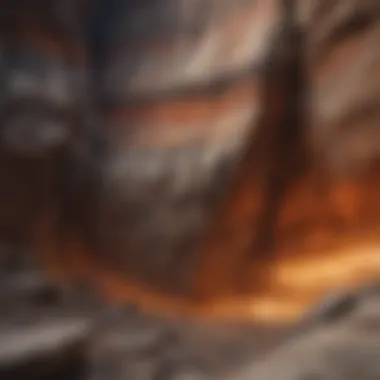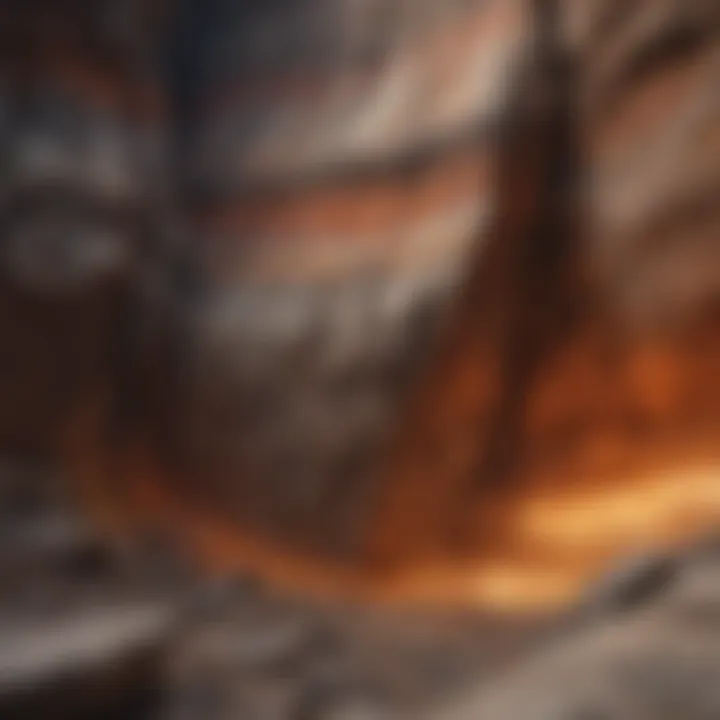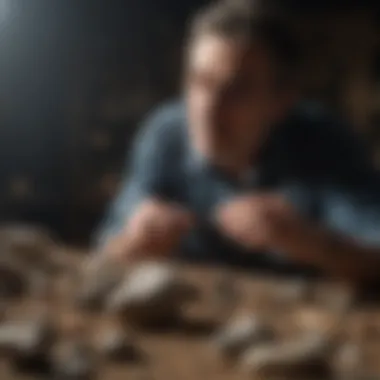Exploring the Impact of Rocks and Fossils on Earth's Past


Intro
Rocks and fossils are often seen as mere remnants of the past, yet they are vital narratives woven into the fabric of Earth's history. They tell stories of ancient landscapes, lost seas, and life forms that once thrived on our planet. Understanding their roles and significance opens a window into the ecological shifts and geological events that have shaped the Earth over millions of years.
Take a moment to consider the layers in a slice of sedimentary rock. Each stratum can represent a different era, a snapshot of time capturing everything from environmental conditions to biological diversity. In essence, they are Earth's history books, waiting to be read.
Moreover, as enthusiasts dive into collecting these ancient clues, they discover not just the scientific value but also the aesthetic charm that rocks and fossils can hold. With this in mind, let’s explore the latest featured collectible that stands out this month.
Preamble to Rocks and Fossils
Rocks and fossils might seem like unassuming elements of Earth’s surface, but they tell a grand tale of our planet's history, a narrative woven through countless years and events. By digging into the interplay between rocks and fossils, we unlock wonders of ancient environments, climates, and life forms. Each rock tells a story of its formation, while fossils hold clues to the creatures that roamed the Earth long before humans took their first steps. Understanding this intertwined relationship not only enriches our knowledge but can also ignite a passion for geology and paleontology among collectors and enthusiasts.
Defining Rocks and Fossils
At the heart of geology lies the definition of rocks. Essentially, rocks are solid aggregates of minerals or mineraloids. They are classified into three main types: igneous, sedimentary, and metamorphic. Each type has its own formation process and characteristics. For example, igneous rocks form from solidified molten material, while sedimentary rocks are the result of compaction and cementation of mineral and organic particles.
On the other side of the coin are fossils, remnants or traces of once-living organisms, encapsulated in rock. By shaping our understanding of biological history, fossils reveal the types of life that existed millions of years ago, and the conditions under which they thrived. Fossils can be categorized as body fossils, which include bones and shells, or trace fossils, such as footprints or burrows, which provide a glimpse into the behavior of ancient species.
The Interconnectedness of Geology and Paleontology
The realms of geology and paleontology are interconnected like two sides of the same coin. Understanding one often enhances our grasp of the other. In geological terms, the layers of the Earth’s crust tell the tale of numerous events, from volcanic eruptions to the slow processes of erosion. Paleontology uses these geological records to paint a picture of how life has evolved in response to those events.
"To study rocks is to unveil the past, while to study fossils is to glimpse the life that once was."
For instance, sedimentary rocks often contain fossils due to the deposition of organic materials under specific environmental conditions. By analyzing these rocks, paleontologists can infer climate changes and ecological shifts over geological time scales. This relationship encourages not just a scientific inquiry into the ages of rocks and fossils, but a philosophical reflection on life’s transient nature on our planet.
Ultimately, this exploration highlights that every rock we encounter could have been part of a thriving ecosystem or a tranquil beach, setting the stage for the life forms that existed in its vicinity. This shared journey of rocks and fossils resonates deeply with collectors, as they hold fragments of history that pique our curiosity and foster a connection to the past.
The Formation of Rocks
The journey of understanding rocks begins with their formation, which is fundamental to comprehending Earth's history. Rocks are not just lifeless aggregates of minerals; they record ancient climates, geological events, and even the evolution of life itself. By studying their formation, we tap into a treasure trove of information that narrates the story of our planet.
Types of Rocks: Igneous, Sedimentary, and Metamorphic
Rocks are broadly classified into three categories based on their formation processes: igneous, sedimentary, and metamorphic. Each type serves as a clue in the vast geological puzzle.
- Igneous Rocks: These rocks form from the cooling and solidification of molten rock, known as magma. If the magma cools slowly beneath the Earth's surface, it leads to the creation of rocks like granite; when it erupts onto the surface as lava, it solidifies quickly into basalt. The appearance of igneous rocks can often give insight into the conditions under which they formed. For example, coarse textures indicate a slow cooling process.
- Sedimentary Rocks: These arise from the accumulation and lithification of mineral and organic particles. Sediment can come from various sources, such as weathering of existing rocks, plant debris, or even the remains of organisms long gone. Sedimentary layers encode information about past environments, demonstrating changes in conditions like sea level fluctuations or climate shifts. Classic examples are limestone, formed from marine organisms, and shale, composed of compressed mud.
- Metamorphic Rocks: These rocks originate from existing igneous or sedimentary rocks that undergo transformation due to extreme heat and pressure. This metamorphosis can alter mineral compositions, physical structures, and overall appearances. For instance, limestone can change into marble. Such transformations often offer tantalizing clues about tectonic movements and the geologic forces shaping our landscape.
Rock Cycle: An Overview
The rock cycle is a dynamic and ongoing process that describes the transformations between the three rock types. It illustrates how one form of rock can evolve into another and emphasizes the interconnectedness of geological processes.
Here’s a simplified view of the rock cycle:
- Weathering and Erosion: Rocks are continuously broken down through weathering and erosion, leading to sediment formation.
- Sedimentation and Compaction: Over time, sediments accumulate and compact to form sedimentary rocks.
- Metamorphism: If sedimentary rocks are buried deep within the Earth, they may experience heat and pressure, thereby becoming metamorphic rocks.
- Melting: Continued heat can melt these rocks back into magma, completing the cycle.
- Cooling: Magma can rise to the surface and cool to form igneous rocks.
This cyclical nature reveals that rocks are not static entities, but rather participants in the dynamic processes that continue to shape the Earth's surface. By tracing the pathways in the rock cycle, geologists not only uncover the history written in rocks but also anticipate future geological changes.
Understanding the rock cycle is crucial; it helps us acknowledge how deeply intertwined our world is with geological processes.
In summary, rocks’ formation—a complex interplay of physical and chemical processes—reveals the narrative of Earth's past environments, life forms, and the ongoing geological evolution. This foundational knowledge serves both enthusiasts and scholars alike, fostering a deeper appreciation for the rugged beauty and intricate histories locked within Earth's crust.
Understanding Fossilization
Fossilization is a cornerstone of paleontology, providing key insights into the life forms that inhabited our planet long before humans walked the Earth. The importance of understanding fossilization lies in its ability to bridge the gap between past and present, mapping out how life has changed over millions of years. By gripping the complexities of this process, enthusiasts can glean knowledge that enhances their appreciation for the rocks and fossils they collect.
The Fossilization Process
The fossilization process is a series of events that transforms organic material into fossils. This transformation doesn't happen overnight; it can take thousands, even millions of years. To simplify, one can think of it like cooking a good stew—there are various ingredients and steps involved that influence the final flavor.


- Death: First, an organism must die. It sounds straightforward but timing is essential: for most creatures, quick burial is crucial to preserve them from scavengers and decomposition.
- Burial: The remains need to be buried under layers of sediment, such as mud or sand. Over time, these layers build up, exerting pressure and creating conditions that encourage fossilization.
- Mineralization: As water seeps through the sediment, it carries minerals. These minerals replace the organic materials in bones or shells, solidifying them into hard, rock-like structures. This can occur through permineralization or the more strikingly beautiful cast and mold processes.
- Adaptation and Erosion: Over time, geological forces may adapt the surrounding sediments. Erosion—caused by wind, water, or other natural phenomena—eventually reveals these ancient remains, allowing collectors and scientists to uncover their stories.
Understanding this process gives collectors insight into not only what they may find but also the age and significance of their discoveries. For those who find it captivating, knowing how a creature transformed into a fossil can deepen their connection to it.
Conditions Favorable for Fossil Formation
Fossil formation isn't just a matter of happenstance; certain conditions favor it significantly. Different environments can yield fossils—some can bestow an astounding variety while others can produce almost none. Here are key conditions to take into account:
- Quick Burial: The sooner an organism is buried, the better its chances for preservation. Rapid sedimentation—often found in river deltas or lakebeds—is ideal.
- Anaerobic Environment: A lack of oxygen slows decay processes. Environments such as swamps or bogs, where decomposers are limited, are prime locations for forming fossils.
- Mineral-Rich Water: As mentioned before, mineral-rich water helps in replacing organic materials. Areas where groundwater is plentiful can assist in the initial stages of fossilization.
- Stable Geological Conditions: Frequent geological shifts like earthquakes can disrupt the fossilization process. A stable setting is more conducive to preserving remains.
"Proper conditions can turn a mundane death into an artifact that traverses the imaginaries of time."
With these factors in mind, rock and fossil collectors can better target their search and understand the stories behind their finds. Embracing the nuances of fossilization is indispensable for anyone intrigued by the relics of Earth's bygone eras.
Types of Fossils
Understanding the different types of fossils is crucial in grasping how they narrate Earth’s history. Fossils provide insights into ancient life forms, ecosystems that existed long ago, and the environmental changes that occurred over millions of years. The two primary categories of fossils are body fossils and trace fossils. Each category plays a distinctive role in our understanding of the past.
Body Fossils and Trace Fossils
Body fossils are what many enthusiasts picture when they think of fossils. These are the preserved remains of ancient organisms, including bones, teeth, shells, and even whole organisms in some cases. They directly represent the physical characteristics of the organisms from which they came. For instance, the fossilized bones of dinosaurs like Tyrannosaurus rex tell us about their size and structure, contributing immensely to our knowledge of these magnificent creatures.
On the other side, trace fossils are a bit more subtle yet equally fascinating. They include any indirect evidence of past life, like footprints, burrows, and feces. For example, a set of dinosaur footprints found in sedimentary rock doesn't just showcase the creature's size; it can also inform us about their behavior, movement patterns, and the environment they inhabited.
In a nutshell, studying both body and trace fossils provides a fuller picture of the ancient ecosystems. While body fossils show us the organisms that lived, trace fossils reveal their interactions with the environment and each other, painting a multifaceted portrait of life on Earth.
Preservation Types: Unaltered, Permineralized, and Casts
Fossils can form through various processes, and understanding these processes provides insight into how well-preserved a specimen might be. Broadly, fossil preservation can be categorized into three types: unaltered, permineralized, and casts.
- Unaltered fossils are quite rare and occur when the original organic material is preserved without significant changes. This can happen in some environments, like the icy conditions of Siberia, where mammoths have been discovered with soft tissues intact.
- Permineralized fossils happen when minerals seep into the organic remains, often turning them into rock over long periods. This leads to incredibly detailed preservation, capturing the intricate structures of bones or wood, as seen in fossilized trees known as petrified wood.
- Casts, on the other hand, form when an organism leaves a void behind, often filled later with sediment or minerals, creating a mold of the original material. These can provide significant information about the organism's shape and environment.
Each type of preservation tells a story and reveals different aspects of the ancient organisms and their worlds. Mastering these concepts enhances our appreciation for the rich narrative Earth’s fossils hold.
"Fossils not only provide a window into the distant past but also enhance our understanding of the dynamics of life on Earth."
The array of fossils types speaks volumes about Earth’s biological history and aids our understanding in a myriad of ways. For collectors and enthusiasts, grasping the significance of these types and their preservation is indispensable in learning how to properly interpret the stories that these fossils embody.
This foundational knowledge makes engaging with rocks and fossils all the more rewarding, as you can better understand the narratives that have shaped our planet.
What Rocks and Fossils Reveal About Earth
Rocks and fossils act like time capsules, carrying secrets about Earth's history within their layers and forms. Understanding what they reveal can profoundly deepen our appreciation of the planet's past environments and life forms. This section sheds light on the significance and the insights gained from analyzing these natural artifacts.
Interpreting Ancient Environments
Rocks and fossils are invaluable in reconstructing ancient landscapes. Geologists study sedimentary rocks to uncover how ancient seas, rivers, and deserts have evolved over eons. For instance, layers of limestone may indicate the previous existence of a shallow sea. When we engage in stratigraphic analysis, we can decipher the conditions that led to sediment deposition and the subsequent geological history.
Fossils, particularly those of plants and animals, provide layers of context that further complete the picture. For example, the presence of coal deposits suggests lush forests once thrived in that location. Similarly, marine fossils may indicate that an area was once submerged under water. By piecing these clues together, scientists create a narrative of climatic shifts, continental drift, and environmental changes that have sculpted our world.
As one might say, “It’s like fitting puzzle pieces together, but the picture is of our planet’s long-gone landscapes.” These methods enable researchers to not only track physical changes in the Earth’s surface but also to make inferences about ancient climates and habitats.
By studying rock layers and fossils, we can glimpse into the Earth’s past, revealing ocean depths, ancient forests, and even volcanic eruptions that shaped our planet.
Insights into Ancient Life Forms
The fossil record serves as a window into the evolution of life through the ages. Each fossil tells its own story, revealing how species adapted to their environments over millions of years. Scientists utilize fossils to establish timelines that track evolutionary changes. Consider the example of dinosaur fossils; they provide information on their size, structure, and lifestyle. In particular, trace fossils, such as footprints or nests, illustrate behavior and interaction within ecosystems.
Moreover, studying the composition of rocks that contain fossils adds another layer of understanding. The type of minerals present can indicate the conditions under which organisms thrived. For instance, the presence of certain isotopes in fossils might suggest what the creatures ate or how they metabolized their food.
Thus, the analysis of rocks and fossils helps define not just the existence of ancient creatures but also how they lived, what they ate, and even why they became extinct. Such studies have led to uncovering critical insights into past mass extinctions, environmental pressures, and species survival or extinction, thereby setting the stage for understanding biodiversity today


Benefits of delving into rocks and fossils include:
- Uncovering evolutionary history: Grasp how life forms have changed over time.
- Understanding extinction events: Investigate what factors led to the demise of species.
- Highlighting ecological connections: Explore how various forms of life responded to geological transformations.
The Role of Rocks in Our Ecosystem
Rocks have more significance than what lies beneath their surfaces; they are foundational elements of our ecosystem. These geological components serve essential functions that support life on Earth, establishing the framework for landscapes, influencing climate, and contributing to the natural resources we depend on. Understanding their role provides insight into how ecosystems function and highlights the importance of conserving these materials.
Soil Formation and Agriculture
Soil is often dubbed the lifeblood of agriculture. It composes various minerals from rocks, which break down over millennia, mixing with organic matter, air, and water. Without this rock-to-soil relationship, we would face dire challenges in food production. The erosion and weathering of rocks create nutrients essential for plant growth:
- Weathering: This is the breaking down of rocks into smaller particles through physical, chemical, and biological processes. This step is crucial in creating different types of soil, each with its unique properties.
- Nutrient Supply: As rocks break apart, they release minerals like potassium, phosphorus, and magnesium, essential for robust crop development.
- Water Retention: Soil formed from rock exerts a significant influence on water management for ecosystems. Good soil collects water efficiently, preventing floods while supplying consistent moisture to plants.
Thus, the processes of soil creation and nutrient cycling through rocks foster both agriculture and natural plant communities, sustaining not just human life, but all living entities that rely on land-based ecosystems.
Natural Resource Extraction
The role of rocks also extends into our use of natural resources. Different types of rocks host valuable minerals and materials that power industries and shape economies. Extracting resources from rocks comes with considerable benefits and responsibilities:
- Minerals and Metals: Sedimentary rocks often contain deposits of coal, oil, and natural gas, which form the backbone of transportation and energy production. Other rocks yield valuable metals like gold, silver, and copper, integral for technology and infrastructure.
- Building Materials: Igneous and metamorphic rocks, such as granite and marble, are esteemed for their strength and aesthetic appeal in construction. They help create the buildings and roads that shape our urban landscape.
- Environmental Considerations: Since natural resource extraction can lead to habitat destruction and pollution, it is vital to pursue sustainable practices. This includes mindful exploitation, recycling materials, and advocating for renewable options wherever possible.
The careful management of rock resources not only meets human needs but also protects the ecological networks that rely on these geological foundations.
By understanding the duality of rocks' benefits and impacts, we recognize their critical position within our ecosystems. As we navigate the challenges posed by modern development, prioritizing sustainable interactions with these natural elements is crucial. The synergy between rocks, soil, and resources showcases their essential role in maintaining a balanced and functioning ecosystem.
Collecting and Preserving Rocks and Fossils
The activity of collecting rocks and fossils is more than just a hobby; it is a gateway into understanding the intricacies of Earth's history. Each piece you gather can offer insights about the environment from which it came. Treating these natural treasures with respect is paramount. This section delves into the significance of proper collecting and preserving methods, highlighting the tangible benefits this careful approach can yield for both the collector and the broader scientific community.
Best Practices for Collectors
When it comes to rock and fossil collecting, a few key practices can ensure that your efforts bear fruit while also maintaining the integrity of the specimens found. Here are some best practices to keep in mind:
- Know the Regulations: Before heading out on an expedition, familiarize yourself with local collecting laws. Many regions have restrictions on fossil collection, especially in protected areas.
- Research Your Locations: Understanding where to collect is vital. Look into geological maps or visit local museum resources to find prime locations. Being informed about the history of the area can make your collecting journey more fruitful.
- Use Appropriate Tools: Simple tools like trowels, brushes, and geological hammers are essential. It is also wise to bring magnifying glasses for more intricate specimens. Avoid using tools that can damage the fossil or rock matrix.
- Document Your Findings: Keeping a record of where and when a specimen was found can be very useful. Photos, along with detailed notes, can provide context that is invaluable for future reference or research.
- Respect Natural Habitat: Always clean up after yourself. Leave the collecting site as you found it to preserve the ecological balance and allow others to enjoy the experience.
Each of these practices enhances not just personal satisfaction from the collection but also contributes to the collective knowledge of geology and paleontology. The stories told by these specimens must be preserved accurately.
Techniques for Preservation
Once you have collected your rocks and fossils, it’s crucial to preserve them properly to ensure their longevity. Different types of specimens require unique treatments, but here are some fundamental techniques that apply to a broad range:
- Gentle Cleaning: Start by removing any loose dirt or debris using a soft brush. For harder residues, distilled water can help dislodge stubborn materials. Avoid household cleaners, as they may contain chemicals that could damage the specimen.
- Sealing and Stabilization: Some fossils may benefit from being sealed to prevent moisture damage. Products like Paraloid B-72 are excellent for this purpose as they provide a strong yet clear coating. Applying these seals needs a careful approach to avoid altering the appearance of the specimen.
- Proper Storage: Store your specimens in stable environments. Avoid direct sunlight, as UV rays can fade colors and degrade materials over time. Use acid-free boxes or containers to prevent chemical reactions that might arise from more common materials.
- Temperature and Humidity Control: Keeping your rocks and fossils at suitable temperatures and humidity levels is crucial. A consistent climate can help prevent cracking and other forms of deterioration.
- Labeling: Each rock or fossil should be properly labeled with its information. Details like the location of collection, date, and any relevant geological data will add invaluable context.
"Preserving not only the specimen but also its history may breathe life into what would otherwise be, simply, stone."
By employing these techniques, collectors can contribute to the ongoing narrative of Earth's history, ensuring that future generations can appreciate the stories locked within these incredible natural records. The act of collecting and preserving is not just an engagement with geology but also an act of stewardship for our planet's heritage.
Educational Value of Rocks and Fossils
Rocks and fossils are not just remnants of the past; they are vibrant educational tools that open up a treasure chest of knowledge for those willing to explore them. Understanding these geological and paleontological wonders helps unravel the narrative of Earth’s history. It’s like reading a captivating book where every chapter tells a story of ancient times, environments, and life forms. The educational value here can’t be overstated.
Key Benefits of Incorporating Rocks and Fossils into Education:
- Understanding Earth's Processes: Students dive into how rocks form, transform, and are eroded, gaining insights into the dynamic nature of our planet.
- Fostering Critical Thinking: When learners analyze fossils, they develop skills to interpret data and make connections. Forms they find lead to questions about evolution and adaptation.
- Connecting with Nature: Engaging with physical specimens promotes a sense of stewardship for the environment. This connection inspires respect for nature and can motivate conservation efforts.
Furthermore, engaging with rocks and fossils encourages curiosity. Imagine a child holding a trilobite fossil for the first time; the wide eyes and bubbling excitement can ignite a passion for geology or paleontology that lasts a lifetime.
"Rocks and fossils tell the stories of Earth’s past, much like family heirlooms carry tales of generations gone by."


Inspiring Future Scientists
Encouraging students to explore the world of rocks and fossils can spark their interest in science careers. Engaging experiences—such as field trips to natural history museums or local geological sites—provide hands-on learning opportunities.
The beauty of these collections lies in their diversity. Students can study fossils of creatures that lived millions of years ago and understand not just biology but also how life adapts to changing environments. The intricate details found in rock formations showcase geologic time scales that teach about continental drift and plate tectonics.
By participating in mineral shows or fossil hunts, young enthusiasts can interact with seasoned collectors and scientists. This exposure serves as a mentoring platform, guiding them through the nuances of scientific inquiry. It’s this kind of engagement that leads to innovation and the next generation of geologists and paleontologists.
Using Fossils in Teaching
Fossils can transform classrooms into laboratories where the past meets the present. When educators use fossils as teaching tools, they give students a tangible link to previous epochs.
- Creating Interactive Lessons: Using fossils, educators can prepare lessons on evolution, environment, and extinction. Activities might include:
- Enhancing Curriculum Standards: Fossil studies fit seamlessly into science curricula, aligning with state and national educational standards. They provide opportunities for interdisciplinary connections, inspiring lessons in history, geography, and art.
- Field-Based Learning: Fossil digs or visits to quarries can bring the subject to life. These experiences help to cultivate critical skills such as teamwork, problem-solving, and observation.
- Hands-on fossil identification games
- Virtual simulations of past ecosystems
In summary, the educational value of rocks and fossils lies in their ability to captivate minds and inspire curiosity. As students piece together the clues left behind in these natural records, they not only learn about geology and paleontology but engage in a timeless quest for knowledge.
Community and Networking for Enthusiasts
The world of rocks and fossils is more than just a solitary endeavor. Engaging with a community of like-minded enthusiasts can be incredibly rewarding, opening doors to shared knowledge, experiences, and opportunities for collaboration. Whether you’re a novice collector or a seasoned expert, networking enriches your journey in numerous ways. For one, it allows you to access a reservoir of information that might not be available through traditional channels. From understanding the latest finds to grasping the intricacies of geological processes, the collective wisdom of a community can vastly expand your horizons.
Moreover, establishing connections can lead to hands-on experiences that ignite your passion further. Imagine being invited to an excavation site, where you can dig for fossils alongside fellow enthusiasts and professionals alike. These experiences not only deepen your appreciation for natural history but also foster friendships that can last a lifetime. There’s a certain camaraderie that forms when people share the excitement of discovery, which can often be a solitary pursuit.
In essence, community engagement enhances your understanding, reinforces your commitment to the field, and empowers you to contribute meaningfully to the preservation of geological heritage.
Joining Clubs and Organizations
When it comes to joining clubs or organizations, the options are as varied as the fossils themselves. Local rock and mineral societies or paleontological organizations often provide the backbone for networking within your community. They usually host regular meetings, lectures, field trips, and workshops that keep members engaged while disseminating invaluable knowledge. These gatherings can be a treasure trove of learning, offering insights into the latest research in geology and paleontology.
Furthermore, clubs often facilitate connections with experienced collectors and researchers, who can mentor newcomers. This direct line to expert knowledge can help you navigate the complexities of identification, preservation, and ethical collecting. Members often share resources, from field locations renowned for fossil finds to tools and techniques for effective collection.
- Benefits of Club Membership:
- Access to exclusive field trips and events
- Networking with experts in geology and paleontology
- Opportunities for community outreach and education
- Resources on the latest research findings
Joining these groups not only broadens your knowledge base but also provides a sense of belonging within a vast and often niche field that can feel isolating at times. There's an intrinsic value in sharing experiences with others who understand the joys and challenges of this pursuit.
Online Resources and Forums
In the digital age, online resources and forums act as a lifeline for rock and fossil enthusiasts. Platforms like Reddit and Facebook offer spaces to ask questions, share discoveries, and discuss best practices. These online communities facilitate real-time exchanges, connecting individuals who might be continents apart yet share a profound interest in Earth’s history.
- Benefits of Online Communities:
- Instant feedback on identification of specimens
- Virtual meet-ups with experts for knowledge sharing
- Groups dedicated to specific interests, such as mineral collecting or paleobotany
- Access to a global network of individuals with varying levels of expertise
Social media groups and forums create an inclusive environment where members can post pictures of their latest finds, ask for advice on preservation methods, or even arrange meet-ups for collecting trips. These interactions underpin a growing sense of global community, making the world of rocks and fossils much more accessible.
"In today’s world, connecting with fellow enthusiasts is just a click away, making geology and paleontology a collaborative journey rather than a lone expedition."
The Internet can provide a quick answer, or another perspective on a question you've pondered upon for ages. Ultimately, diving into these digital waters can enhance your passion, sharpen your skills, and broaden your view on the wonders held within our planet.
Ending: Reflecting on the Importance of Rocks and Fossils
As we draw the curtain on this exploration of rocks and fossils, it becomes clear that these natural elements do far more than just sit in our collections or clutter our gardens. They are vital messengers from the past, crafting a narrative that helps us understand the history of our planet. The importance of rocks and fossils in geological studies cannot be overstated. They paint a picture of ancient climates, ecosystems, and life forms, a picture that is continually being enriched through new discoveries and technologies.
The Historical Significance of Geological Studies
Rocks serve as a timeline, chronicling events from the formation of the Earth over 4.5 billion years ago to the ever-changing landscapes we see today. Each layer of sedimentary rock tells a story—fossils encased within them sometimes show creatures that walked the Earth millions of years before humanity existed. For instance, shale deposits in the Burgess Shale formations reveal a complex marine ecosystem dating back to the Cambrian period, showcasing early forms of life. Researchers and enthusiasts alike utilize these geological records to trace evolutionary histories and understand shifts in biodiversity over eons.
Furthermore, understanding these historical aspects aids in predicting future environmental changes. With climate change altering many natural landscapes today, looking back at how different geological periods responded to ecological stresses can provide insights into current crisis management. Certainly, these rocks and fossils are much more than pretty decorations for a shelf—they encapsulate significant lessons about resilience and adaptation in the face of adversity.
Encouraging Lifelong Learning in Geology and Paleontology
The journey into the vastness of geology and paleontology is one that fosters relentless curiosity and ignites a lifetime of exploration. For both new and seasoned collectors, the study of rocks and fossils does more than just expand one's knowledge base; it nurtures an appreciation for the intricate balance of life on Earth. A simple trip to a local quarry or a well-planned excavation can spark curiosity that leads to decades of study and discovery.
As budding scientists scoop up layers of soil, clump dirt off their finds, or take notes about where they dug, they are engaging more than just a hobby. They are immersing themselves in a field that teaches patience, attention to detail, and critical thinking. Resources such as educational forums on reddit.com, or organizations like the Geological Society, provide platforms for learning and sharing experiences.



